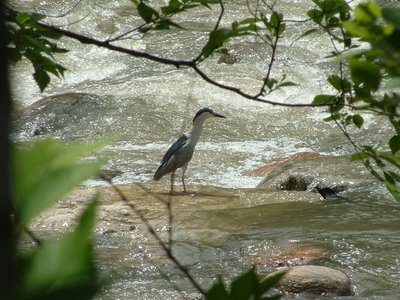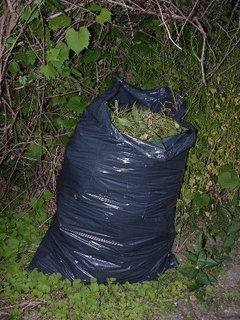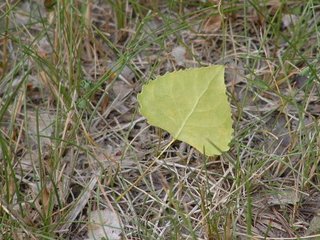
I saw at least three night herons putting in some overtime in the middle of the day:

A blog about my experience with the Community Stewardship Program at the Beechwood Wetland site (and the surrounding area) along the Don River in Toronto, Ontario, Canada. There will be pictures, anecdotes and garlic mustard galore.

I was heading over to the pond to look at the water level there when -- score! I bagged the muskrat:
It kindly allowed me to take some publicity photos, but then it was time to get back to work.
I moved a few steps closer to the pond and suddenly a great blue heron rose up out of nowhere and flapped off. Alas, no photo. I went back to taking pictures and met up with the muskrat again a few minutes later. Snack time:

I decided to stay away from the pond and stop hassling the poor creature. There was lots to capture my attention on dry land as well, including some interesting caterpillars:

[A few days later: I believe the caterpillar above will become a mullein moth.]
I snipped the top off a thistle but left the rest standing when I noticed this little creature:

As I was walking through some goldenrod I noticed how tall everything is getting. I wonder if I'll be in over my head by the end of the summer? I may have to take a tall guide to help me navigate around the site.
I'm seeing a lot of galls on the goldenrod:

These are caused by the goldenrod gall fly, which deposits eggs in goldenrod stems. A larva hatches and starts eating the stem, and a smooth ball forms around it in response to the damage and to a chemical the larva secretes. This makes a perfect nursery where the larva can overwinter before emerging as an adult in the spring.

This tree is native to Canada but not to our area; it belongs farther west, as you've figured out from the name. The wood is weak and susceptible to breakage (although those roots are pretty strong!) and because this maple grows and reproduces quickly, it would crowd out our desired species if left unchecked.
Another target was the Canada thistle. I felt some pangs at destroying this lovely symbol of my Scottish heritage. Oh well, I'm not that Scottish, so I hardened my heart and snipped off the tops ...

... which were bagged to prevent the spread of seeds. The rest of the plant we just cut and left on the ground. These thistles will also grow from buds on their root system, but if we can keep the tops cut off the plants should eventually starve. Here's a slaughtered thistle:

The fruits of our labours:

 ... while Justin, Norah and I secured plastic under the ones on the sloping banks of the pond.
... while Justin, Norah and I secured plastic under the ones on the sloping banks of the pond.

Meanwhile, Jenny and Leigh worked on mapping some of the invasive plants at the site. Finally the group tackled a stand of garlic mustard. This is another of the invasives we'd like to eradicate before it takes over completely. It's a biennial; in its first year it forms a rosette of leaves like this:

In its second year it grows a tall stalk that bears a little white flower. (Sorry, I neglected to get a photo at that stage.) Once it's finished flowering it gets busy producing seed pods:

Here's a patch of it growing across the path from the site:

We cut the stalks off and stuffed them into a giant garbage bag ...

... leaving a scene of devastation:


In other news, the cup plants are doing their thing and retaining water:

Wildlife:

Some of the Japanese knotweed is going all spotty. I'm hoping it's a terrible knotweed blight that will wipe out the population.

Finally, the scene on the way home:
 A member of my research staff (thanks eepy!) suggested that the white fluff along the path is from a cottonwood tree. I did a little research, then set off to try to find one. Soon I had my first clue: a triangular leaf, flat on the bottom, with rounded teeth on the edges.
A member of my research staff (thanks eepy!) suggested that the white fluff along the path is from a cottonwood tree. I did a little research, then set off to try to find one. Soon I had my first clue: a triangular leaf, flat on the bottom, with rounded teeth on the edges.



(Scientific dissecting tool included for scale.)
They're quite hard and desiccated, so my scientific dissecting tool wasn't very effective. I put on some gloves and just tore the pellets apart. They're mainly tightly-packed hair and what looks like dirt, along with a few bones.

Those are some interesting little bones, but I wouldn't say there are a lot of them, so I'll guess these pellets came from a hawk rather than an owl.


Yes, it's a sad, dry little stick, but give it time.
I couldn't help but notice the drifts of fluffy seeds lining the side of the path. Snow in June! I don't know what this fluff is from, but I bet the birds like it for lining nests.


The blue flags are looking very pretty by the pond. I spotted the muskrat towing a long reed or branch. A black-crowned night heron flew by as I was leaving, but I couldn't get him to pose for a picture. Before I reached Pottery Road I also saw cowbirds, a few orioles, and what I'm pretty sure is an oriole nest. I couldn't zoom in any tighter, and I'm not much for climbing trees, so this is the best shot I could get:

At the side of the path I spotted a pellet from an owl or a hawk. I think. Maybe it's just dog poop and I'm an idiot, but that looks like fur in there. Why didn't I take it home with me and dissect it??? If I find it again I'll do that and report back.
Here's a page that explains owl pellets for anyone not familiar with the concept. (This cracks me up: "When an Owl is about to produce a pellet, it will take on a pained expression.") Hawk pellets apparently contain fewer bones, so if I can dissect this thing I might get a clue about the source.
Tune in next week for more exciting adventures!


Here’s the purple flowering part. Isn’t that pretty?

A spectator came to have a look, introducing himself as an educator who works at the Science Centre. He commutes on the bike path and has enjoyed watching the improvements, so he stopped to say hello and learn more about what happens there.
The weather was perfect, sunny but not too warm or humid, and the mosquitoes weren’t bothering me. I seem to have a few ant bites, but I’ll probably survive. This was the scene when we were finished:
Norah and I walked back to Pottery Road and saw a couple of juvenile herons along the way. (That's our best guess and we're sticking to it.) The final wildlife sighting came as we reached the top of the hill: a big gang of bikers hanging out at -- the Dairy Queen!

This is a blog about the Beechwood Wetland area in Toronto and my involvement with it. Last week I went to a meeting of the Community Stewardship Program, a city-sponsored initiative which recruits volunteers to work at various sites around the city. Teams monitor the flora and fauna, improve/restore habitat, remove litter and invasive weeds and plant appropriate native vegetation. I can do that! I get a lot of good out of exploring along the Don River and I'd like to give something back.
After hearing about all the options I signed up to work at the Beechwood Wetland site. It's close to my house, so I can walk there easily -- a big bonus. Our team will meet on-site for the first time this evening to get things started. I've been checking out the site over the past week to familiarize myself with some of the plants -- don't want to pull up the wrong thing!
I must acknowledge the effort and dedication of the Task Force to Bring Back the Don and the city's Parks and Rec department, as well as many other volunteers, who got this project underway. Check out the links in the sidebar for info and pictures about the early days of this wetland site. It's come a long way in a short time thanks to everyone's hard work.
The good: come and enjoy nature without having to leave the city! There's lots of wildlife and vegetation. Over the last few days I've seen a raccoon (okay, they hang out on my balcony too, so not a big thrill), a muskrat and some rabbits, including this baby who sat perfectly still so I wouldn't see him. Good work, bunny, I can hardly see you at all!

It's also a good spot for birdwatching. I've seen more orioles in the past week than I have in all the rest of my life. (Although I have yet to get a good picture. Take my word for it, they're very pretty -- bright orange with black heads -- and they sing sweetly.) Another bird I haven't captured with my camera yet is the black-crowned night heron. There was one flapping along the river last night. I've also noted woodpeckers, song sparrows, loads of red-winged blackbirds, and the more common birds such as robins, starlings and house sparrows.
There's a great variety of wildflowers, and I'm trying to learn more of their names. This beautiful creature is birdsfoot trefoil:

It's also a good place for insect-watching, although I have even more trouble with these than with the plants. Anybody know what kind of caterpillar this is?

The bad: there is a heck of a lot of dog-strangling vine and Japanese knotweed in the valley. These are invasives that threaten to crowd out the native plants, and they're doing a good job so far. I don't think we'll ever win this war, but we can aim for little oases of natural habitat.
These are the flowers of the dog-strangling vine:
Pretty enough, no? Don't be fooled, though, this is the enemy. Here's a little patch of it so you can get an idea of how it takes over: It will grow at an alarming rate and twine itself around trees, eventually bringing them down, or choking them to death, or hogging all their food, or stealing their credit cards, or something. Whatever it does, it's bad. This picture was taken on the opposite side of the river, a bit farther north, but it could happen anywhere.
It will grow at an alarming rate and twine itself around trees, eventually bringing them down, or choking them to death, or hogging all their food, or stealing their credit cards, or something. Whatever it does, it's bad. This picture was taken on the opposite side of the river, a bit farther north, but it could happen anywhere.

Another evil-doer is Japanese knotweed, which also grows rapidly and crowds out everything else. Here it is looking small and innocent enough, but pretty soon it will be turning itself into a bamboo-like forest.
